Complications Among People With Autism
Uncover the challenges faced by individuals with autism. Explore sensory sensitivities, communication difficulties, and more.

Understanding Autism
To shed light on the complexities of autism, it is essential to first gain an understanding of what autism is and the common characteristics associated with it.
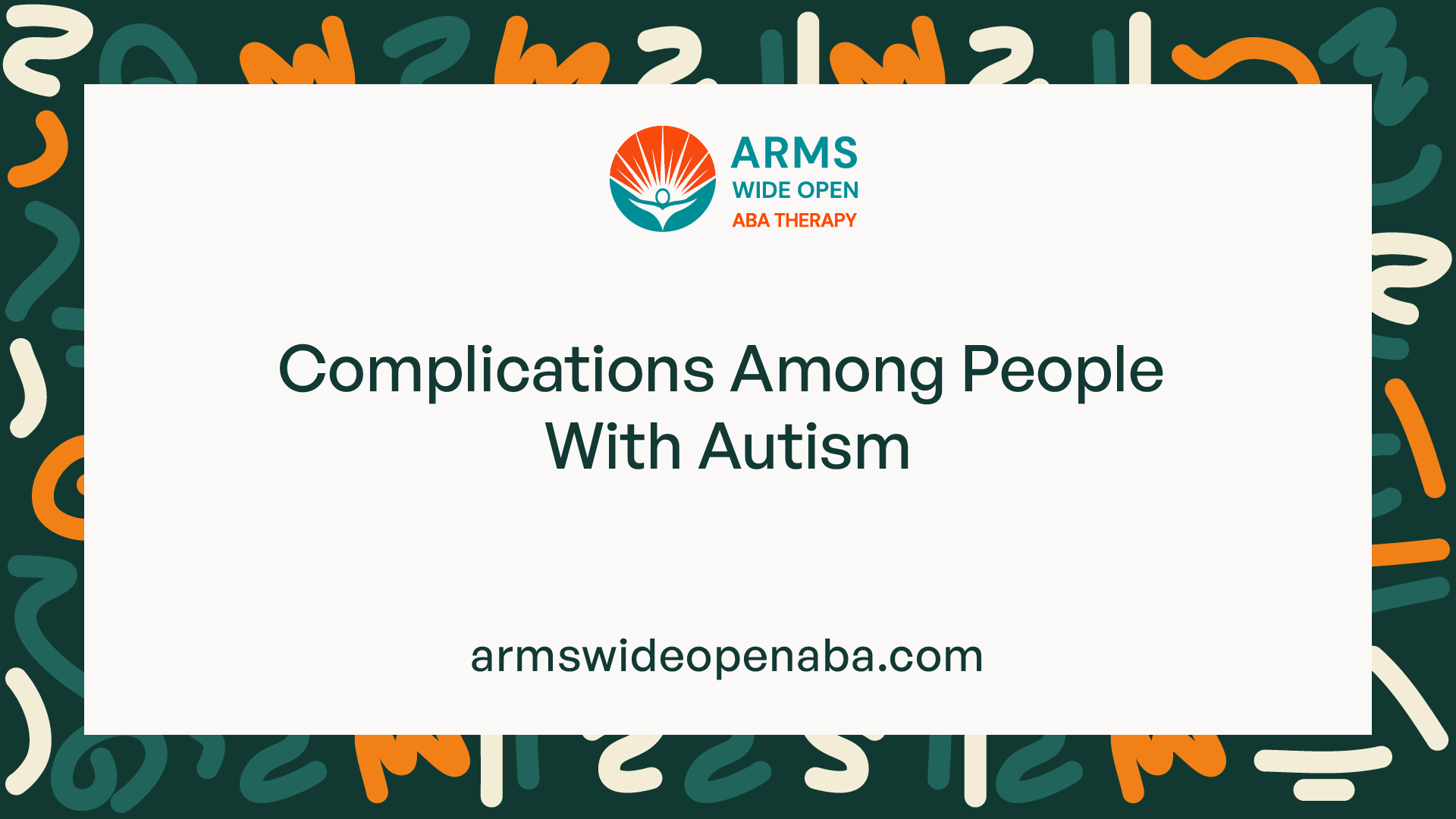
What is Autism?
Autism, also known as Autism Spectrum Disorder (ASD), is a neurodevelopmental disorder that affects individuals in various ways. It is characterized by difficulties in social interaction, communication, and repetitive behaviors or restricted interests. Autism encompasses a wide range of abilities and challenges, with each individual experiencing a unique combination of symptoms and strengths.
Common Characteristics of Autism
While autism manifests differently in each person, there are common characteristics that are often observed. These include:
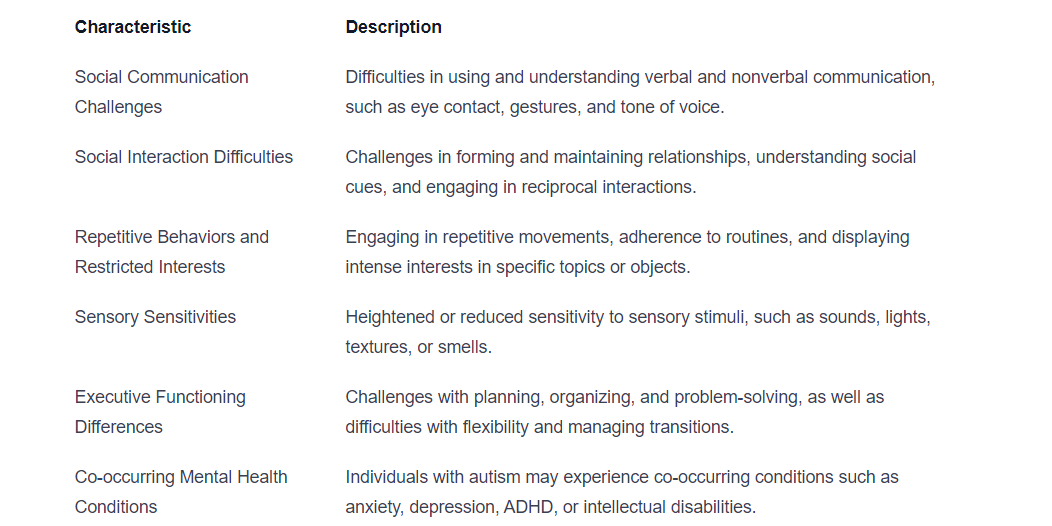
It is important to note that autism is a spectrum disorder, meaning that the severity and combination of these characteristics can vary greatly among individuals. Some individuals may require significant support in daily living, while others may be highly independent and excel in certain areas.
By understanding the fundamental aspects of autism and recognizing the common characteristics associated with it, we can begin to appreciate and address the unique challenges faced by individuals on the autism spectrum. This understanding lays the groundwork for finding effective strategies and support systems to improve the quality of life for individuals with autism.
Unmasking the Challenges
Living with autism comes with a unique set of challenges that individuals may face on a daily basis. Understanding these challenges is crucial for promoting understanding and support. In this section, we will explore some of the common challenges experienced by people with autism, including sensory sensitivities, communication difficulties, social interactions and relationships, executive functioning challenges, and co-occurring mental health conditions.
Sensory Sensitivities
One of the hallmark characteristics of autism is sensory sensitivities. Individuals with autism may experience heightened or diminished sensory responses to various stimuli in their environment. These sensitivities can affect any of the five senses - sight, sound, touch, taste, and smell. For example, some individuals may be extremely sensitive to certain sounds or textures, while others may have difficulty processing visual information or strong odors.
Understanding and accommodating these sensory sensitivities is essential for creating a supportive environment for individuals with autism. By minimizing sensory triggers and providing sensory-friendly spaces, we can help reduce anxiety and promote comfort.
Communication Difficulties
Communication difficulties are another significant challenge faced by individuals with autism. Some individuals may have delayed or limited speech, while others may prefer nonverbal forms of communication. Difficulties in understanding and using language, as well as challenges with social communication, can make it challenging for individuals with autism to express themselves and understand others effectively.
Alternative forms of communication, such as visual supports, sign language, or augmentative and alternative communication (AAC) devices, can greatly enhance communication for individuals with autism. It's important to provide clear and structured communication strategies to facilitate effective interaction and understanding.
Social Interactions and Relationships
Navigating social interactions and building relationships can be particularly challenging for individuals with autism. Difficulties in understanding social cues, interpreting nonverbal communication, and engaging in reciprocal conversations can create barriers in forming connections with others. Social situations that require flexibility and understanding of unwritten rules can be particularly overwhelming.
Supportive interventions, such as social skills training and the use of visual supports, can help individuals with autism develop social understanding and improve their ability to interact with others. Creating inclusive environments that foster acceptance and understanding is crucial for promoting positive social interactions and relationships.
Executive Functioning Challenges
Executive functioning refers to a set of cognitive processes that allow individuals to plan, organize, and manage their thoughts, actions, and emotions. Many individuals with autism experience challenges in executive functioning, which can impact their ability to initiate and complete tasks, manage time, and regulate their emotions.
Implementing strategies such as visual schedules, task breakdowns, and providing clear expectations can support individuals with autism in developing their executive functioning skills. By providing structure and support, we can help individuals with autism thrive in various domains of their lives.
Co-occurring Mental Health Conditions
It's important to recognize that individuals with autism often have co-occurring mental health conditions. Conditions such as anxiety, depression, attention deficit hyperactivity disorder (ADHD), and obsessive-compulsive disorder (OCD) are more prevalent among individuals with autism compared to the general population.
Identifying and addressing these co-occurring mental health conditions is crucial for providing comprehensive support to individuals with autism. Collaborative care involving mental health professionals and autism specialists can help develop effective strategies and interventions to address both the autism and co-occurring mental health conditions.
Understanding these challenges faced by individuals with autism is essential for promoting inclusivity and providing appropriate support. By recognizing and addressing these challenges, we can create a more inclusive and supportive society for individuals with autism.
Educational Challenges
Individuals with autism often face unique educational challenges that require specialized support and accommodations. Understanding these challenges is crucial for creating an inclusive learning environment and promoting the academic success of individuals with autism.
Learning Differences
Autism is characterized by differences in learning styles and processing information. These learning differences can impact various areas, such as language development, academic skills, and social understanding. Some common learning differences among people with autism include:
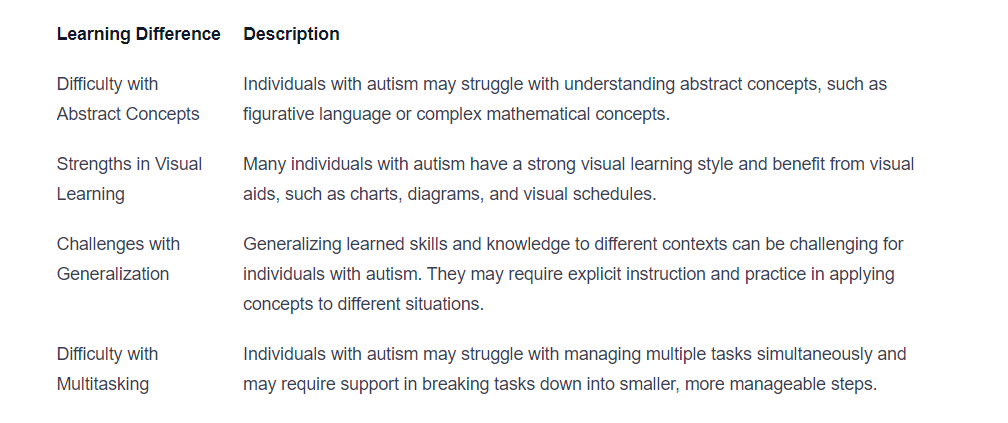
Individualized Education Plans (IEPs)
Individualized Education Plans (IEPs) play a crucial role in addressing the unique educational needs of students with autism. An IEP is a personalized document that outlines the specific goals, accommodations, and services required to support the individual's learning and development. Key components of an IEP for a student with autism may include:
- Specific academic goals tailored to the student's needs, such as improving reading comprehension or developing social skills.
- Accommodations and modifications to the curriculum, such as providing extra time for assignments or breaking tasks into smaller steps.
- Support services, such as speech therapy, occupational therapy, or social skills training, to address specific areas of need.
- Strategies for managing sensory sensitivities and creating a supportive learning environment.
- Regular progress monitoring and periodic review of the IEP to ensure that goals are being met and adjustments are made as needed.
Supportive Strategies in the Classroom
Creating a supportive classroom environment is essential for promoting the academic success of students with autism. Teachers can implement various strategies to meet the unique needs of these students. Some supportive strategies for teaching students with autism include:
- Visual supports: Using visual aids, such as visual schedules, visual cues, and visual organizers, to enhance understanding and promote independence.
- Structured routines and clear expectations: Establishing predictable routines and providing clear instructions can help individuals with autism navigate the classroom environment more effectively.
- Explicit instruction: Breaking down complex tasks into smaller, step-by-step instructions and providing clear explanations can support the learning process for students with autism.
- Sensory considerations: Recognizing and addressing sensory sensitivities by providing a quiet space, minimizing sensory distractions, or allowing the use of sensory tools can create a more comfortable and conducive learning environment.
By understanding the learning differences, utilizing individualized education plans, and implementing supportive strategies in the classroom, educators can help individuals with autism thrive academically and reach their full potential.
Healthcare and Medical Challenges
When it comes to healthcare and medical settings, individuals with autism may face unique challenges that can impact their overall well-being. In this section, we will explore some of the specific healthcare and medical challenges that people with autism may encounter, including sensory overload, access to appropriate healthcare, and addressing co-occurring medical conditions.
Sensory Overload in Healthcare Settings
Healthcare settings can often be overwhelming for individuals with autism due to their sensory sensitivities. The bright lights, loud noises, and unfamiliar environments can lead to sensory overload, causing significant distress and anxiety. Healthcare providers need to be aware of these challenges and take steps to create a more accommodating environment. This may involve providing sensory-friendly waiting areas, using visual supports to enhance communication, and implementing strategies to reduce sensory stimuli during medical procedures.
Access to Appropriate Healthcare
Accessing appropriate healthcare services can be a significant challenge for individuals with autism. They may face barriers such as difficulties in communication, limited understanding of medical procedures, and a lack of healthcare providers who specialize in autism. It is crucial for healthcare systems to prioritize training healthcare professionals in autism awareness and understanding. This can help ensure that individuals with autism receive the appropriate care and support they need.
Addressing Co-occurring Medical Conditions
People with autism often have co-occurring medical conditions that require comprehensive medical management. These conditions may include gastrointestinal issues, sleep disturbances, epilepsy, and mental health disorders. It is essential for healthcare providers to have a holistic approach to care, addressing both the autism-related challenges and the co-occurring medical conditions. Collaborative efforts among healthcare professionals, including specialists in autism and the respective medical conditions, can lead to better outcomes for individuals with autism.
To illustrate the prevalence of co-occurring medical conditions among individuals with autism, here is a table displaying some common conditions:
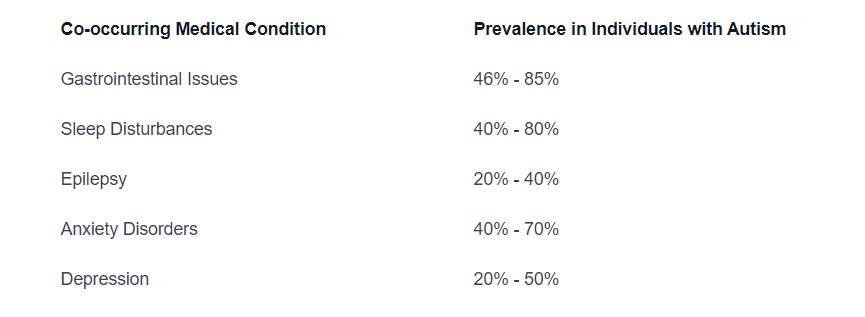
Addressing these co-occurring conditions requires a multidisciplinary approach, involving healthcare providers, therapists, and support networks. It is essential to develop individualized treatment plans that consider the unique needs and challenges of each person with autism.
By understanding and addressing the healthcare and medical challenges faced by individuals with autism, we can work towards creating a more inclusive and supportive healthcare system. Through increased awareness, specialized care, and collaborative efforts, we can ensure that individuals with autism receive the necessary healthcare services and support to lead healthier and fulfilling lives.
Employment and Independence Challenges
Individuals with autism often face unique challenges when it comes to employment and achieving independence. In this section, we will explore two key areas of concern: workplace accommodations and promoting independence and autonomy.
Workplace Accommodations
Creating a supportive work environment is crucial for individuals with autism to thrive in the workplace. Employers can make certain accommodations to help individuals with autism effectively navigate their job responsibilities. These accommodations are designed to address specific challenges that individuals with autism may face, such as sensory sensitivities, communication difficulties, and executive functioning challenges.
Here are some examples of workplace accommodations for individuals with autism:
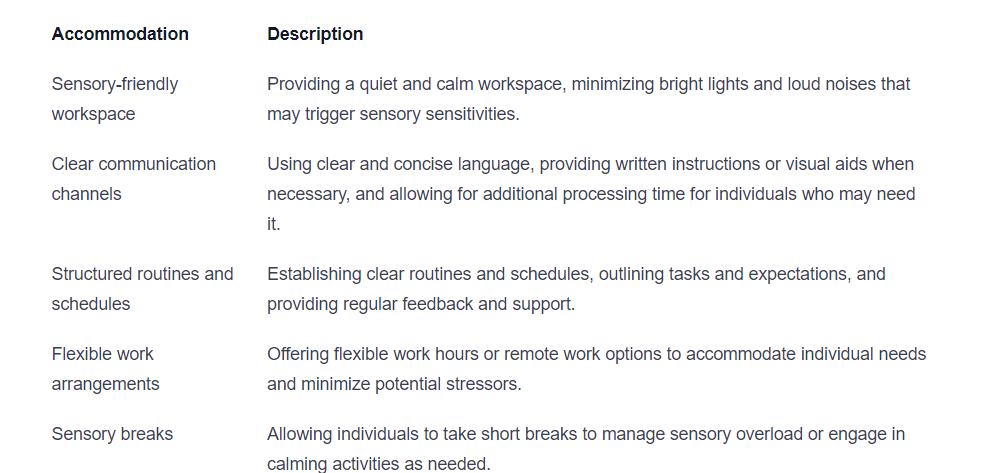
Implementing these accommodations can help individuals with autism feel more comfortable, supported, and productive in the workplace.
Promoting Independence and Autonomy
Promoting independence and autonomy is essential in helping individuals with autism lead fulfilling lives. Encouraging independence involves providing opportunities for individuals to develop essential life skills and make decisions that align with their interests and abilities.
Here are some strategies for promoting independence and autonomy among individuals with autism:
- Life Skills Training: Offering training programs that focus on developing practical skills such as cooking, cleaning, budgeting, and personal hygiene. These programs can empower individuals with autism to become more self-sufficient.
- Social Skills Development: Providing social skills training to enhance communication, emotional regulation, and interpersonal interactions. These skills are crucial for building relationships, both in personal and professional settings.
- Transition Planning: Assisting individuals with autism in transitioning from school to adulthood by creating personalized plans that address their unique needs and goals. This may involve vocational training, job placement assistance, and support in navigating post-secondary education options.
- Self-Advocacy Skills: Encouraging individuals with autism to advocate for themselves, express their needs, and seek support when necessary. Teaching self-advocacy skills empowers individuals to participate actively in decision-making processes and take control of their own lives.
By implementing workplace accommodations and fostering independence and autonomy, individuals with autism can overcome employment challenges and work towards leading independent and meaningful lives. It is crucial for employers, educators, and society as a whole to create an inclusive environment that recognizes and supports the unique abilities and contributions of individuals with autism.
Support and Resources
Navigating the challenges faced by individuals with autism requires access to the right support and resources. In this section, we will explore three important aspects: advocacy and support organizations, therapies and interventions, and building a supportive network.
Advocacy and Support Organizations
Advocacy and support organizations play a crucial role in providing assistance and resources to individuals with autism and their families. These organizations advocate for the rights and needs of people with autism, raise awareness, and offer various support services. They can provide valuable information, guidance, and a sense of community to individuals and families affected by autism.
Here are some notable advocacy and support organizations:

Therapies and Interventions
Therapies and interventions tailored to the specific needs of individuals with autism can significantly improve their quality of life and help them overcome challenges. There are various evidence-based approaches that professionals may use to support individuals with autism.
Here are some common therapies and interventions:
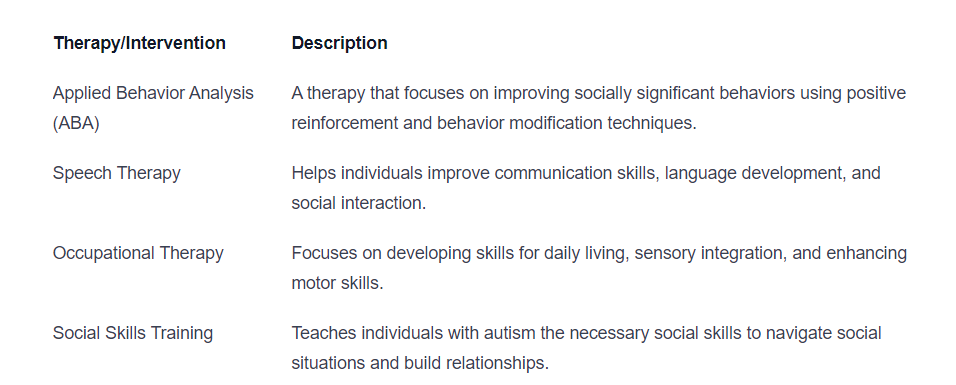
Building a Supportive Network
Building a supportive network is essential for individuals with autism and their families. Connecting with others who understand their experiences can provide a sense of belonging and offer practical support. This network can include family members, friends, educators, therapists, and support groups.
Here are some ways to build a supportive network:
- Join local support groups or online communities specifically for individuals with autism and their families.
- Attend workshops, conferences, or seminars related to autism to connect with others and gain knowledge.
- Engage with professionals, such as therapists or educators, who have experience working with individuals with autism.
- Seek out local organizations or centers that offer support services and opportunities for socialization.
By accessing advocacy and support organizations, utilizing therapies and interventions, and building a supportive network, individuals with autism can receive the assistance and resources they need to overcome challenges and thrive. It's important to remember that support looks different for each individual, so finding the right combination of resources and services is key to promoting their well-being and success.
Sources
https://my.clevelandclinic.org/health/diseases/8855-autism
https://www.healthline.com/health/autism-complications
https://www.autismparentingmagazine.com/autism-people-complications/
Similar articles
We’re here to help you

Our team is here to assist you in this process. Contact us for any assistance.
it’s easy to apply
We Accept Most Insurances
Our in-network insurance partnerships make ABA therapy more accessible to families throughout our service areas.







Our Insurance Process
We'll request your insurance details to help us verify your plan's coverage for ABA therapy. Once we've received this information, we'll walk you through your benefits, including copayments, deductibles and out-of-pocket maximums, so you know what to expect in advance.
Our team will then handle the preauthorization and all the necessary paperwork.
.svg)





















.jpeg)


































.jpeg)




.jpeg)







.jpeg)











.jpeg)
















